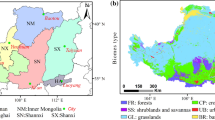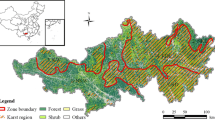Abstract
Aiming for the restoration of degraded ecosystems, many ecological engineering projects have been implemented around the world. This study investigates the ecological engineering project effectiveness on vegetation restoration in the Beijing-Tianjin Sand Source Region (BTSSR) from 2000 to 2010 based on the rain use efficiency (RUE) trend in relation to the land cover. More than half of the BTSSR experienced a vegetation productivity increase from 2000 to 2010, with the increasing intensity being sensitive to the indicators chosen. A clear tendency towards smaller increasing areas was shown when using the net primary productivity (NPP, 51.30%) instead of the accumulated normalized difference vegetation index (59.30%). The short-term variation in the precipitation and intra-seasonal precipitation distribution had a great impact on the remote sensing-based vegetation productivity. However, the residual trends method (RESTREND) effectively eliminated this correlation, while incorporating the variance and skewness of the precipitation distribution increased the models′ ability to explain the vegetation productivity variation. The RUE combined with land cover dynamics was valid for the effectiveness assessment of the ecological engineering projects on vegetation restoration. Particularly, the result based on growing season accumulated normalized difference vegetation index (ΣNDVI) residuals was the most effective, showing that 47.39% of the BTSSR experienced vegetation restoration from 2000 to 2010. The effectiveness of the ecological engineering projects differed for each subarea and was proportional to the strength of ecological engineering. The water erosion region dominated by woodland showed the best restoration, followed by the wind-water erosion crisscross regions, while the wind erosion regions dominated by grassland showed the worst effect. Seriously degraded regions still cover more area in the BTSSR than restored regions. Therefore, more future effort should be put in restoring degraded land.
Similar content being viewed by others
References
Cao S, 2008. Why large-scale afforestation efforts in China have failed to solve the desertification problem. Environmental Science & Technology, 42(6): 1826–1831.
Chen Y, Yang K, He J et al., 2011. Improving land surface temperature modeling for dry land of China. Journal of Geophysical Research: Atmospheres, 116: D20104. doi: 10.1029/2011JD015921
de Jong R, de Bruin S, de Wit A et al., 2011. Analysis of monotonic greening and browning trends from global NDVI time-series. Remote Sensing of Environment, 115(2): 692–702. doi: 10.1016/j.rse.2010.10.011
Du Plessis W, 1999. Linear regression relationships between NDVI, vegetation and rainfall in Etosha National Park, Namibia. Journal of Arid Environments, 42(4): 235–260. doi: 10.1006/jare.1999.0505
Fensholt R, Sandholt I, Rasmussen M S et al., 2006. Evaluation of satellite based primary production modelling in the semiarid Sahel. Remote Sensing of Environment, 105(3): 173–188. doi: 10.1016/j.rse.2006.06.011
Fensholt R, Rasmussen K, Kaspersen P et al., 2013. Assessing land degradation/recovery in the African Sahel from long-term Earth observation based primary productivity and precipitation relationships. Remote Sensing, 5(2): 664–686. doi: 10.3390/rs5020664
Herrmann S M, Anyamba A, Tucker C J, 2005. Recent trends in vegetation dynamics in the African Sahel and their relationship to climate. Global Environmental Change, 15(4): 394–404. doi: 10.1016/j.gloenvcha.2005.08.004
Huang L, Xiao T, Zhao Z et al., 2013. Effects of grassland restoration programs on ecosystems in arid and semiarid China. Journal of Environment Manage, 117: 268–275. doi: 10.1016/j.jenvman.2012.12.04
Huete A, Didan K, Miura T et al., 2002. Overview of the radiometric and biophysical performance of the MODIS vegetation indices. Remote Sensing of Environment, 83(1): 195–213. doi: 10.1016/S0034-4257(02)00096-2
Intergovernmental Panel on Climate Change (IPCC), 2006. IPCC Guidelines for National Greenhouse Gas Inventories. Hayama, Japan: Institute for Global Environmental Strategies.
Julien Y, Sobrino J A, 2010. Comparison of cloud-reconstruction methods for time series of composite NDVI data. Remote Sensing of Environment, 114(3): 618–625. doi: 10.1016/j.rse. 2009.11.001
Kendall M G, 1938. A new measure of rank correlation. Biometrika, 30(1/2): 81–93.
Liu J, Li S, Ouyang Z et al., 2008. Ecological and socioeconomic effects of China’s policies for ecosystem services. Proceedings of the National Academy of Sciences, 105(28): 9477–9482. doi: 10.1073/pnas.0706436105
Long Huiling, Li Xiaobing, Wang Hong et al., 2010. Net primary productivity (NPP) of grassland ecosystem and its relationship with climate in Inner Mongolia. Acta Ecologica Sinica, 30(5): 1367–1378. (in Chinese)
Ludwig J A, Bastin G N, Chewings V H et al., 2007. Leakiness: a new index for monitoring the health of arid and semiarid landscapes using remotely sensed vegetation cover and elevation data. Ecological Indicators, 7(2): 442–454. doi: 10.1016/j. ecolind.2006.05.001
Ma Q, 2004. Appraisal of tree planting options to control desertification: experiences from Three-North Shelterbelt Programme. International Forestry Review, 6(3–4): 327–334. doi: 10.1505/ifor.6.3.327.59972
Mao Dehua, Wang Zongming, Wu Changshan et al., 2014. Examining forest net primary productivity dynamics and driving forces in northeastern china during 1982–2010. Chinese Geographical Science, 24(6): 631–646. doi: 10.1007/s11769-014-0662-9
Piao S L, Ciais P, Huang Y et al., 2010. The impacts of climate change on water resources and agriculture in China. Nature, 467: 43–51. doi: 10.1038/nature09364
Potter C S, Randerson J T, Field C B et al., 1993. Terrestrial ecosystem production: a process model based on global satellite and surface data. Global Biogeochemical Cycles, 7(4): 811–841. doi: 10.1029/93GB02725
Prince S D, 1991. Satellite remote-sensing of primary production: comparison of results for Sahelian grasslands from 1981 to 1988. International Journal of Remote Sensing, 12(6): 1301–1311. doi: 10.1080/01431169108929728
Sen P K, 1968. Estimates of the regression coefficient based on Kendall’s tau. Journal of the American Statistical Association, 63(324): 1379–1389. doi: 10.1080/01621459.1968.10480934
Stokes A, Sotir R, Chen W et al., 2010. Soil bio-and ecoengineering in China: past experience and future priorities preface. Ecological Engineering, 36(3): 247–257. doi: 10.1016/j.ecoleng.2009.07.008
Topaloglu F, 2006. Regional trend detection of Turkish river flows. Nordic Hydrology, 37: 165–182.
Tucker C J, Dregne H E, Newcomb W W, 1991. Expansion and contraction of the Sahara Desert from 1980 to 1990. Science, 253(5017): 299–301. doi: 10.1126/science.253.5017.299
Tucker C J, Slayback D A, Pinzon J E et al., 2001. Higher northern latitude normalized difference vegetation index and growing season trends from 1982 to 1999. International Journal of Biometeorology, 45(4): 184–190. doi: 10.1007/s00484-001-0109-8
Wang G, Innes J L, Lei J et al., 2007. China’s forestry reforms. Science, 318(5856): 1556. doi: 10.1126/science.1147247
Wang X M, Zhang C X, Hasi E et al., 2010. Has the Three Norths Forest Shelterbelt Program solved the desertification and dust storm problems in arid and semiarid China? Journal of Arid Environments, 74(1): 13–22. doi: 10.1016/j.jaridenv.2009.08.001
Wessels K, Prince S D, Malherbe J et al., 2007. Can human-induced land degradation be distinguished from the effects of rainfall variability? A case study in South Africa. Journal of Arid Environments, 68(2): 271–297. doi: 10.1016/j.jaridenv.2006.05.015
Wu Bo, Li Xiaosong, Liu Wen et al., 2006. Desertification control regionalization and rehabilitation counter measures of source area of sand and dust endangering Beijing-Tianjin. Scientia Silave Sinicae, 42(10): 65–70. (in Chinese)
Wu J, Zhao L, Zheng Y et al., 2012. Regional differences in the relationship between climatic factors, vegetation, land surface conditions, and dust weather in China’s Beijing-Tianjin Sand Source Region. Natural Hazards, 62(1): 31–44. doi: 10.1007/s 11069-011-0039-7
Wu Z, Wu J, Liu J et al., 2013. Increasing terrestrial vegetation activity of ecological restoration program in the Beijing–Tianjin Sand Source Region of China. Ecological Engineering, 52: 37–50. doi: 10.1016/j.ecoleng.2012.12.040
Yang X, Ci L, 2008. Comment on’ Why large-scale afforestation efforts in China have failed to solve the desertification problem’. Environmental Science & Technology, 42(20): 7722–7723.
Zhang G, Dong J, Xiao X et al., 2012. Effectiveness of ecological restoration projects in Horqin Sandy Land, China based on SPOT-VGT NDVI data. Ecological Engineering, 38(1): 20–29. doi: 10.1016/j.ecoleng.2011.09.005
Zhang L, Li X, Yuan Q et al., 2014. Object-based approach to national land cover mapping using HJ satellite imagery. Journal of Applied Remote Sensing, 8(1): 083686. doi: 10.1117/1.JRS.8.083686
Zhang Lei, Wu Bingfang, Li Xiaosong et al., 2014. Classification system of China land cover for carbon budget. Acta Ecologica Sinica, 34(24): 1–8. (in Chinese)
Zhang T T, Zeng S L, Gao Y et al., 2011. Using hyperspectral vegetation indices as a proxy to monitor soil salinity. Ecological Indicators, 11(6): 1552–1562. doi: 10.1016/j.ecolind.2011.03.025
Zhao B, Yan Y, Guo H et al., 2009. Monitoring rapid vegetation succession in estuarine wetland using time series MODISbased indicators: an application in the Yangtze River Delta area. Ecological Indicators, 9(2): 346–356. doi: 10.1016/j. ecolind.2008.05.009
Zhao M S, Running S W, 2010. Drought-induced reduction in global terrestrial net primary production from 2000 through 2009. Science, 329: 940–943. doi: 10.1126/science.1192666
Zhu Wenquan, Pan Yaozhong, Long Zhonghua et al., 2005. Estimating net primary productivity of terrestrial vegetation based on GIS and RS: a case study in Inner Mongolia, China. Journal of Remote Sensing, 9(3): 300–307. (in Chinese)
Zhu W Q, Pan Y Z, Liu X et al., 2006. Spatio-temporal distribution of net primary productivity along the northeast China transect and its response to climatic change. Journal of Forestry Research, 17(2): 93–98. doi: 10.1007/s11676-006-0022-4
Author information
Authors and Affiliations
Corresponding author
Additional information
Foundation item: Under the auspices of National Natural Science Foundation of China (No. 41571421), National Science and Technology Major Project of China (No. 21-Y30B05-9001-13/15)
Rights and permissions
About this article
Cite this article
Li, X., Wang, H., Zhou, S. et al. Did ecological engineering projects have a significant effect on large-scale vegetation restoration in Beijing-Tianjin Sand Source Region, China? A remote sensing approach. Chin. Geogr. Sci. 26, 216–228 (2016). https://doi.org/10.1007/s11769-016-0801-6
Received:
Accepted:
Published:
Issue Date:
DOI: https://doi.org/10.1007/s11769-016-0801-6




